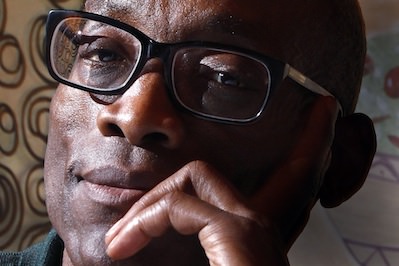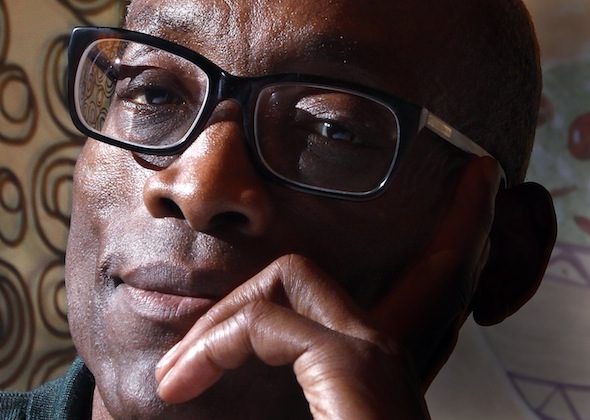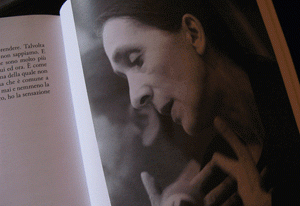Story/Time
"Story/Time: The Life of an Idea," by acclaimed dancer-choreographer Bill T. Jones, reads like the origin story of a superhero, in which the most intriguing parts revolve around how the superhero discovers and acquires his power.

Dancer-choreographer and author of “Story/Time” Bill T. Jones. Photo by AP/Carlo Allegri
|
To see long excerpts from “Story/Time” at Google Books, click here. |
“Story/Time: The Life of an Idea” A book by Bill T. Jones
“Story/Time: The Life of an Idea,” by the acclaimed dancer and choreographer Bill T. Jones, is an odd amalgam of texts. In the preface, Jones tells the reader that “The object you are holding in your hands is conflicted. It is a performance yearning to be a document, a book. . . . It is the record of a needy, angry and confused man. The need is for a tradition, an intellectual home. The anger is generated from an ever-maturing realization that I never truly had an intellectual home and never will.” Throughout the book’s three sections, this conflict between performance and document was both frustrating and riveting, and ultimately, satisfying.
“Past Time” and “With Time,” the two prose essays that bookend the short book, are taken from lectures Jones gave at Princeton University, and are filled with personal and deep insights into what shaped and continues to shape Bill T. Jones as an artist. He covers a lot in a short time, everything from the influence of the experimental composer John Cage, to his experience as a black artist, to the purpose of dance in the 21st century. I’ve seen only a few live performances by Jones’ company, Bill T. Jones/Arnie Zane Dance Company, but the pieces were accessible, breathtaking and always in search of some elemental truth. They were at once heightened and pedestrian. As a fan, the essays read like the origin story of a superhero. And like those legends, the most intriguing parts revolve around how the superhero discovers and acquires his power.
In “Past Time,” we get an in-depth account of Jones’ awakening: how a chance encounter at a John Cage performance at SUNY Binghamton was ground zero for Jones the artist. It can be said that the book’s subtitle, “The Life of an Idea,” is really about how this one performance, witnessed in 1972, plants a seed that informs Jones’ entire artistic life:
I start with this memory because that night proved to be a sort of second birth, or coming into consciousness, of the world of ideas or what one might call a tradition or artistic discourse…
Though I had come to the university with every notion of being an actor and discovered dance along the way, that night made it possible for me to realize that performance as art making would be a means by which I could validate my place in the world. Amid all the hurly-burly of the counterculture, with its mind-expanding drugs, music, and various other roads to transcendence, I felt uneasy. Did I experience this unease because of my race? My sexuality? Was it just being young during the Cold War? For whatever reason, I needed a way to understand how to live in this world — and art making, performance, became that…
Earlier I referred to a tradition of artistic discourse because it expands the notion of art making beyond the commonly held views of it as the individual pursuit of masterpieces and the glory/immortality they are supposed to bestow. Discourse expands art practice into something broader, more democratic — a participation in the world of ideas.
In the essay that ends the book, “With Time,” we delve deeper into the intersection between Jones the man and Jones the artist, as he reconciles an art form that seems to stray further and further from his own cultural beginnings. Jones recounts a story about a piece where he asked his dancers to dance as themselves at a party. Afterward, a young cousin who attended the performance says to him, “Uncle Bill, I’ll be honest with you — I don’t usually understand your dances, but that part, I could really feel.” The comment pleases Jones for a very specific reason:
She was a rare viewer of my work: young, working-class, Black . . . She represented a community I had — justifiably or not — felt estranged from . . . Because the type of work I have engaged in and generated since the beginning of my career demanded I leave this community. (Or did this community leave me?).
But we really experience this contradiction only in the middle section of the book. Sandwiched between the two essays “Past Time” and “With Time,” lies an experiential attempt to document Jones’ dance piece, “Story/Time.”
In “Story/Time,” the performance, Jones, recently retired from dancing, sits at a desk onstage and tells 60 one-minute stories from his life, chosen at random order, as dancers in his company move around him. The unplanned juxtaposition of movement and text is the performance. For Jones, the idea of art as chance is directly linked to John Cage’s work “Indeterminacy,” in which John Cage tells short stories in much the same way, as tweets, beeps and other sounds randomly surround his steady, hypnotic voice.
Each of the stories in the “Story/Time” section fill one page each, the free form text superimposed over a 60 second time grid divided into 10 second segments, to give you a feeling of the passage of time. Or perhaps to direct you on how you should be reading it. But Jones might have easily skipped this format. The stories themselves, however brief, are compelling. They are often moving, and cover a broad range of topics: his own family, his travels as an artist, his surprising encounters with other artists. Some are sober, many are humorous, and most read like poems:
0”
10”
20” It was the summer of 1981 or so and I 30” was performing a solo on a makeshift stage as part of a daylong arts festival in Milwaukee. My friend Renata Sack had driven from Waterloo, Iowa to see me and join her good friend Ruth Gau, 40” just recently returned from China. That afternoon I went shopping with the two of them in a vast vintage clothing warehouse. At one point they were suggesting shirts that would suit me. 50” Ruth held to my chest a 50s-era shirt in red and gold, asking how I liked it. I said with some scorn, “I’m not into nostalgia!” She answered: “You will be.”The brevity and poignancy of the stories reminded me of a book of Buddhist sayings, where the reader is to read one each day and meditate over it. For Jones, this would not be an entirely negative response to the work. Despite its minimalism, it is clear that Jones is an engaging storyteller. While some of the passages pass by like a bohemian’s version of SNL’s “Deep Thoughts by Jack Handy,” Jones is able to capture an amazing range of character, time, place, mood and thought. With the restriction of time he has placed on himself — one minute — the stories have a power in their brevity. There is no time to slowly find the rhythm of the story; like movement, one is immediately thrust into a time and place. There is no time to think or consider:
0”
10” As Arnie set up his camera to photograph Louise Nevelson on the roof of the Stanhope Hotel in San 20” Francisco in 1973 or ‘74 they chatted. Nevelson was in her late 50s, wearing her signature floor-length paisley coat with chinchilla lining, a headscarf, three sets of false 30” eyelashes, and a jockey’s cap. “What do you do other than photos?” she asked. “I’m a dancer,” he said. “Fantastic! Every artist must dance. Now, shall we begin?” 40” She hawked up a wad of phlegm, spat it out, and then, like a fashion model, pulled the fur around her and stared directly into the camera’s lens 50” .
The stories accomplish in half the time what the essays yearn to do, proving yet again that prose is never as efficient as poetry. Jones doesn’t shy away from this point, even questioning an artist’s need to explain himself:
0” At some point in the late ‘80s, Betty Freeman rented Alice Tully Hall for one night so as to present the music of Lou Harrison, which had not been heard in NY for some time. 10” It was a major event in the music world and in the crowd was Virgil Thomson who had known Lou Harrison for many years. 20” Lou Harrison took the stage in a bubbly, flamboyant manner, describing in lengthy detail his pre- 30” occupation with the music of Asia as opposed to the tyranny of “that small tip of Asia Minor we call Europe” 40” Virgil, seated alone swathed in an extravagant colorful Afghani robe, 50” which Bill Katz had just wrapped him in, shouted out at the top of his voice: “Talk, talk, talk . . . When do we hear the music?”
Jones has managed to include both the talk and the music in his book. However, while I found the “Story/Time” section compelling, the dance piece was designed for the choreography to chance upon the stories and thereby create a moment, where the whole became something more than the sum of its parts. Obviously, I was missing the dancers.
0” Anna — or was it Estella? — told the story of a young male relative in the South living on a remote farm back in the days when young boys had to wear short 10” pants. As the story goes, he was sitting on a fence, looking down the road that ran past his family’s farm, when his mother said, “Hey, today is your birthday and you’re a 20” man!”
30”
40” Without so much as a word to anyone,
50” he went into the house, changed from short pants to long ones, and left — never to be heard from again!
It may be a mere 10 seconds here or 20 seconds there, but how were those silences filled? When did the dancing inform the rhythm and meaning of the text, and when did it not? With just the words, we can only guess.
And while Jones and the editors had chosen the printed order of the stories using the website Random.org, once the pages were published, the stories were no longer random. One story will always follow the story before it in this structured, solid object I hold in my hands, and the sense of chance is lost. The experience isn’t exactly lacking, but it isn’t complete either.
But even with only words to present his creativity, it is evident that Jones is as fiercely intelligent as he is inspired. He is fully aware of his artistic process, and what’s more, fully aware of his awareness. We understand that for Jones, being an artist means to question everything, relentlessly, including his own motivations. We know this through the essays, but we feel it through the stories.
0”
10”
20” At a luncheon one day in Washington I sat next to Geoffrey 30” Holder. At one point I asked him his opinion on my choice for a new stage work based on Super Fly, the movie. He said “Marvelous!” I asked him what he thought people 40” would think about me making a work based on what they might think was an exploitation of Black culture and Black people. 50” He mouthed the words: “Fuck them”
At its core, “Story/Time: The Life of an Idea” supports the idea of what an acting teacher of mine once called the “perpetual dissatisfaction” of the artist. Jones continually asks probing questions, about his world, his chosen art of expression and most inspiringly, about himself. Despite the obvious missing elements, I continued to think about the stories and the book as a whole, many days after I had read it. Like a good performance, snippets of it continued to resonate with me, over and over again. It turns out that I appreciated being able to linger in the words at my own pace, without the distraction of lithe bodies or the obligation of having to experience something. The book could never be the performance, but the book itself creates its own time and space. The reader becomes the performer, and in this way, the book succeeds.
Independent journalism is under threat and overshadowed by heavily funded mainstream media.
You can help level the playing field. Become a member.
Your tax-deductible contribution keeps us digging beneath the headlines to give you thought-provoking, investigative reporting and analysis that unearths what's really happening- without compromise.
Give today to support our courageous, independent journalists.




You need to be a supporter to comment.
There are currently no responses to this article.
Be the first to respond.